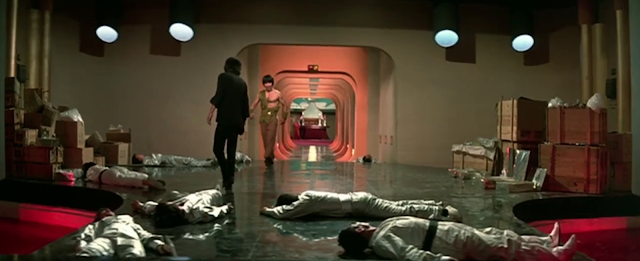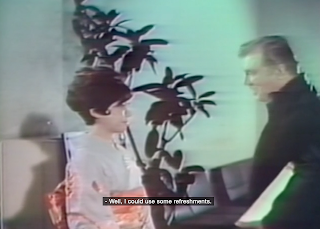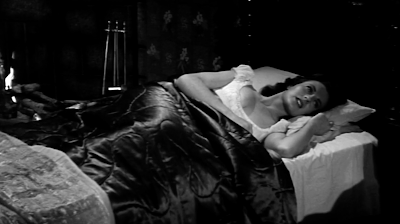We've barely begun and already doubling, flashbacks and mistakes commingle with the alleged forward momentum of the narrative, if trying to confuse even the most astute of viewers as to whether the guy they're watching is supposed to be the actual Bruce Lee in flashback, or his character Billy Lo (who alternates between old Lee clips and his back-of-the-head double), or his college student pornography-owning, flaking-out-on-his-training brother Bobby. Whatever the truth, I don't care. The laconic nature of the first half, its laid-back clip show flashback reminiscences, imbues the film with a mellow glow that carries through to the rest of the remaining hour as young Bobby Lo ("Don't worry father, I won't let it bother me"), Billy's (aka Bruce's) kid brother, decides to go full-on super spy to investigate Billy's death. Soon he's engaging in a fun, perhaps unintentionally goofy, spin on Enter the Dragon's midnight black suit secret agent basement drug production lair skulking, i.e. the best part of that film.
But first! Billy learns his friend Chin Lu (the guy with the peerless sword technique) has been killed! He decides he must be the one to go to tell Lu's sister, a performer in Japan, the bad news. Rather than just call he goes to find her, allowing for a b-roll plunge into the nighttime world of 'the Ginza.' We hear a very Japanese rock/pop singer song of the moment (sounds like, but I'm sure it's not, Meiko Kaji) as Lee/Lo threads his way through the stock footage streets to find the nightclub where she sings as underdressed waitresses lope around in bunny ears and customers watch glumly from their tables, as if it's the 100th take of the night. Even with all that torpor, a fight erupts in her dressing room between Lee/Lo and a horde of assassins. Someone helpfully kicks out the lightbulb so a double can be used for most of the shots. Then our hero goes running through the streets which resemble a kind of sad indoor mall. Where are we anyway? Is this a real place in the Ginza, or a big soundstage recreation? Are supposed to be outside in the night, just a bad set, or is it some kind of actual indoor vendor hall? Never will we know!
Next up, Lee/Lo goes to visit Bobby (Tae-jeong Kim) at college; but Bobby is wasting his time with pornography and non-martial arts studies. We see hands reading an erotic Chinese book then throwing it in the trash. They are Lo/Lee's!? Is he is at his kid brother Bobby's apartment or house or garage? Never will we know! He throws all his brother's dirty magazines into the trash basket, and then starts penning a letter
"Dear Bobby - how are you? I was hoping to see you but you were out; sorry I missed you. I guess I don't have to tell you that to become an expert in kung fu requires more effort."
Lo/Lee leaves him the family secret boxing manual, as if knowing he's about to die and it mustn't fall into enemy's hands. At any rate, he's off to a funeral! A very Ennio Morricone-ish surge of blazing brass and vocalizing heralds a visit to a fancy pagoda for Lu's wake, where marital arts trainees in black, like an army of Japanese Lee replacements waiting to go, stand motionless along all the sides of the walkway. That seems to be a thing. Lots of pagodas. Lots of standing still along pagoda steps by guys in matching karate clothes.
The funeral is Shinto Buddhist. Astute viewers realize instantly Lu's not really dead when four muscly guys in white won't let Lo get close enough to view the body. Lo runs into a Japanese guy and we see the swastika (in the right direction) on the casket. Hey, Buddhism is so much more cosmic than Christianity. The art shows a much clearer understanding of universal energy flows, the circular breathing of the monks echoes eternity.
And when a helicopter comes to steal the casket the circuit is complete.
Lee/Lo is so adamant at getting a look at the body, he hitches a ride grabbing onto the claws the chopper uses to steal the casket, only to drop down and fall to his death from hundreds of feet in the air. Now, it's Billy Lo aka Lee who is dead! But also-- the real Bruce Lee is dead!! Now we get Lee's real funeral with dissolve overlays of his whole career, from child actor onwards, a whole photo album of Lee's life, overlaid with footage of his funeral ceremony.
Well if you got to go, the best way is to do it while falling off of a coffin claw from three hundred feet. "After you've read this letter, go to Japan," reads dad's letter to young Bobby, "and avenge your brother, Billy."
Bobby visits a wealthy white guy named Sherman (he looks a little like Daniel Day Lewis - coincidence?) who eats raw meat and drinks a pink milk cocktail for breakfast. ("This is raw venison, and deer's blood!") Lewis gives Bobby a tour of the grounds, pausing briefly fight to the death three idiot martial artists who arrive at the gate to challenge him. It's funny that Lewis, the only white guy in the whole film, is the worst dubbed, with a voice all halting and unevenly accenting the wrong words, as he shows off his grounds ("I keep a lot of specially trained.... peacocks... over there. They obey my command. It takes a lot of training.") '
Then, in case it was all getting too familiar, Lewis (who Bobby calls Sherman for some reason, perhaps reading a different script) makes a signal and a whole flock of peacocks fly out of their aerie, across the vast lawn and right towards the camera! The sight of them all squawking and coming straight for us all at once out of the opposite end of the frame is scary and most of all, totally unique. We also see lions just hanging out in the garden. ("They are really big lions!" observes Bobby, "I'm kind of frightened.") At one point they surround the jeep and we learn "their favorite dish is fresh human meat").
Bobby sleeps over at Lewis's estate and is visited first by an under-clothed Anglo lady named Angel (Miranda Austin) who tries to first mate with, and then kill, him. A guy in a reasonably convincing lion suit, acting like a lion (he may or may not be supposed to be an actual lion -we never quite know) comes flying through the window a little later in the night. Hey, we've seen less convincing lion suits that were supposed to be actual lions (i.e. Latitude Zero).
But it turns out it's not Lewis sending these hit women and animals. Turns out there's also someone trying to kill Lewis and Bobby: someone wearing a crazy red mask--he's out there skulking in all black around the day-for-night grounds as well. Lewis still may be the guilty one who ordered Billy's death, but Bobby still fights the guy trying to kill him. By now everyone seems 'masked' and doubled so it's just pure joy.
Clues finally lead to the "Tower of Death" but the secret is - the tower is in reverse!! That's not what a tower is called, man! It's called a pit. But there you go. An elevator takes Bobby down down to a very cool combination of James Bond super villain lair, a 1960s TV Batman cliffhanger death trap and Han's underground opium processing plant in Enter the Dragon. Rivers of red blood (or some kind of red liquid) flank a grey/silver industrial sci-fi room with ridged booby trap-laden hallways. Instead of Dragon's hall of mirrors we get the spinning throw room. An electrified grid of colored lasers
Deadpan before Death!
END OF PLOT
I usually don't do the whole "step-by-step plot explain"-style blog posts as I think they're kind of lazy, even tacky, but in some case it's all just so weird you have to lay it out just to understand it yourself. Second hand descriptions only enhance Game and its deliberately confusing Lee compositing. With a star kind of Frankensteined together with other movie's outtakes, stunt doubles, stand-ins, dubbers, and playing fictional characters, the idea of narrative and of acting roles is exposed as the sham act it is, fuel for the hypnotist that is us. It takes many viewings to savvy all this, grasshopper, so let me help you skip the first dozen tries. It takes a lot of training! Now let those peacock's fly, "Sherman!"




































